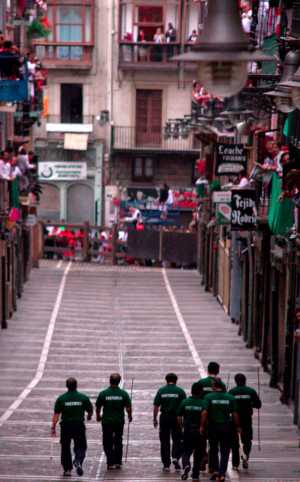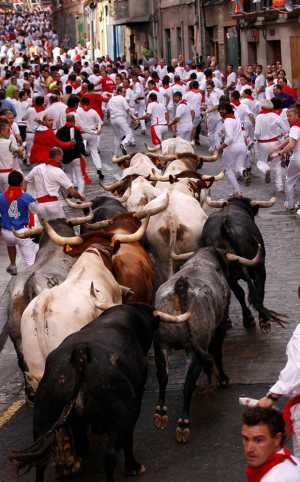According to the legend, Saint Fermin from Amiens was a Christian missionary and the first bishop from Amien. He was born in Pompoaelo (known as Pamplona these days), he was the son of a pagan senator whose name was Firmo, he was an important delegate from the Roman government who govern Pamplona in the III century and was beheaded when he was 31 years old.
“The first time I went there I thought, I as a bullfight lover would have an amazing experience but when I was there, running with all the people, my first thought was that I was really crazy to put my self into this situation. Fear, adrenaline and tension run continuously through all my body, even though the previous minutes before 8:00 am are horribly special but then, when the six bulls run by your side and you sweat all the adrenaline, that moment is absolutely priceless”, Garcia Gil tells me.”
The Legend
Under the custody of Saint Honest from Nimes, the young Fermin learned religion and speech art.

When he was 18 years old he was sent to Tolosa, the place where he would become a priest and after organizing the local church construction, he became a Bishop when he was 24 years old.
The legend continued to grow in time and his saint day is celebrated July 7th. That celebration takes place in Pamplona, Navarra’s Capital, but it is well known all over the world, the name of those days of celebration is Sanfermines, famous for their bulls and bullfights.
Celebrations begin with the launching of the chupinazo (rocket) that takes place from the City Hall’s balcony in Pamplona at noon on July 6th and they end at midnight on July 14th with “poor me” (pobre de mí), the farewell song.
One of the most famous activities of the Sanfermines, without a doubt, is the bullfighting spectacle (encierro). It is a route of 849 meters where people go ahead the bulls and it ends in the bullring, this kind of bullfights happens daily between the 7th and the 14th of July, they start at eight am and last for an average of two or three minutes.
Although the sanfermines festival has an ancestral origin, its fame increased after Ernst Hemingway talked and wrote about it. He described perfectly all its magical environment in his book Fiesta (party). In which he narrates, for example, the death of a boy from the bull’s goring.
It is, unquestionably, a singular festival and also it is the main reason why Pamplona is known around the world.
There are three different celebrations in origin: The religious gatherings honoring San Fermin, the trade shows, and the bullfights. Centuries ago San Fermin was celebrated every October 10th but soon the inclement weather made them change because it was so cold those days.

Having the weather situation in the back of their minds, in 1951 they decided to change the festivals to July 7th, I bullfights was held in Pamplona on that same dates so they decided to gather both festivities in just one big celebration.
I realized that there are a lot of misunderstands and false ideas around these festivities. One of them is to think that San Fermin is Pamplona’s patron when he was the patron indeed but not just for Pamplona but also for the entire Navarra’s province, an honor that he shares with Saint Francis Xavier. Pamplona’s patron is Saint Saturnine or Saint Cernin, Toulouse’s bishop and martyr.
The most interesting thing about this festivities is the festive atmosphere, the people, the celebration itself, the change to discover great traditions and being able to enjoy a city that lives 100% for the celebration all the eight days, Marta says thrilled.
Since the ’50s, San Fermin has had many changes, the first one is that the live level has increased. They have lost some of the religious fervor even though the procession is still massive.
Perhaps it doesn’t have the same charm that it had at the beginning but they still sing the Jota to the saint in the council’s square and the Agur Jaunak in front of Saint Cernin’s church.
The Chupinazo
The Chupinazo is one of the greatest and the most expected moments, basically, it is a rocket’s launch every 6th of July on the balcony in the governor’s house in Pamplona. The launching is a public notice that Sanfermines has begun.

The origin of this tradition started in the first years of the XX century when lots of people started to gather together for the rocket’s launch.
In 1941, was the first time when the launching took place from the government house balcony, Joaquin Ilundain was in charged of lighting The Chupinazo’s fuse.
Right after that, they adopt the costume that the alderman that launched the rocket was also the President from the Municipal parties committee.
Since July 6th, 1941 a traditional shout says: “Men and women from San Fermin hurray San Fermin! Gora San Fermin!
Solkes: Why you go to San Fermin?
MGG: I go because I declare myself a bullfight lover and I am truly fonder of that entire wonderful world that surrounds bullfighting. San Fermin is a bullfight temple that hooks all of us that love bullfights. The cattle herds take the best of their animals to San Fermin and the bulls are really spectacular, the faces, the horns, and the bulls ‘structures that you see in Pamplona are not common everywhere else.
The Bullfight
San Fermin’s bullfights have a medieval origin, it all began with the shepherd’s “entrance”. Navarran shepherds brought the bulls from the suburbs around Navarra to the major square, which was a kind of bullfight pit since they didn’t have one.
It is about to “lead” the herd of bulls and steers until they arrive at the bullfight pit, they come from Santo Domingo’s corrals that are 849 meters close, they exit at 8 o´clock after spending the night over there.
There are many places for the people to see the “encierro”. As a matter of fact, the entire thing can be seen from the wooden fences and protections that are all around the streets.
The first festivities’ bullfight takes place on the 7th of July and the last one happens on the 14th.
When people are standing near the fences, the atmosphere, the fear, the stress, the shouting penetrates the skin.
Others watch the “show” from some private and expensive balcony. Some people watch it from the bullfight pit, where the entrance is free during weekdays and it is really cheap and affordable on weekends and feast days.
Even though there are many who don’t believe or try to ignore them, there are certain security rules for running with the bulls. It is a must. Needles to say that they must be followed if not the consequences may be massive.
The rules are: not to stand up immediately in case of a fall, cover the head with both arms in a fetal position in risk of serious gored. It is also forbidden to run with hand backs or video and photo cameras, hands must be free every time.
The Dianas
The journey in San Fermin begins with the music from the Dianas. At 6:45 am “The Pamplonesa” Local Band is ready to go over the streets in the Old town.
“… If you join the “encierro” you must respect the ritual, respect the other runners and respect the animal. I would love to see people acting carefully and with the sense of responsibility that the show itself and the whole concept implies and not going there with out a clue of what´s going on”, states Marta Garcia Gil.
It is crucial to understand that at that time many townspeople are just arriving home after the party last night.
The Dianas is a tradition that has existed for more than a hundred years.
The public is with them always, the crowd sings all of the songs and if there are tourists, there are always tourists involved, and they don’t know the words they make noises. As time goes by more and more people join the march around the streets. The band plays restlessly all the songs.
Las Peñas (The bullfight clubs)
When the bullfight clubs exit it is one of the most amusing moments of all, it is priceless. The bullfight clubs are a little friend or crew groups that have a passion in common: The San Fermines. I know some of them and it is amazing for local and foreign, they are always in every bullfight.
The First Bullfight clubs were founded in the mid-nineteen-century when Pamplona was just the Old Town.
The Bullfight clubs are the main characters in every bullfight afternoon during sanfermines since they were born by and for the San Fermin festivities.
I imagined every thing bigger and the streets much more wide, the first time I was here I thought it was impossible that in so less area there would fit all that people running between 6 bulls. I was also impressed by the noise and the sound around the streets during the running. The screams trying to find their echoes between the corridors of people and the noise of the bulls’ legs on the cobblestones are really impressive, explains Marta.
Other activities
I must say that certainly there are bullfights and as they assured me this is a festivity that revolves around the bulls and it is a festivity between the bull’s farms but the environment and the party atmosphere is festive some times it is even disrespectful with brave acts such as the ones we get to see there, I must say I got impressed.

When the sun sets and the night arrives, the party begins, or rather the sky just changes its color because the party never stops. People get astonished by the fireworks that are launched from the citadel since 11:00 in the night, also those who have that romantic sense can watch the “encierrillo”, when the next day bulls are conducted from the Gas corrals before the next day’s running.
Today, Pamplona is too small to accommodate the large number of visitors and tourists that it has yearly. But this is Spain and this count´s main quality is its hospitality. There’s always a quite festive atmosphere in the streets, foreigners feel at home and they are driven by sanfermines legend. This is a really great week, everything, the people, the atmosphere, the festivities all those elements are completely harmonious and great. Gora San Fermin!


